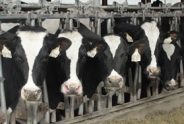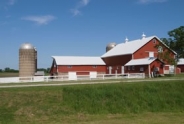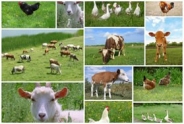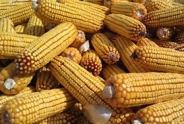Managing Pinkeye in Cattle
Amy Barkley, Team Leader & Livestock Specialist
Southwest New York Dairy, Livestock and Field Crops Program
Managing Pinkeye in Cattle
Pinkeye is a highly contagious disease of cattle which can affect individuals of any age and line. It develops when the causative bacterium, Moraxella bovis, combines with factors that weaken the eye allow the bacteria to enter.
While any animal can be affected, it is more commonly seen in calves, since they have not yet developed protective antibodies on the surface of their eyes to ward off bacteria. Regarding gender, bull calves are more prone to developing this condition than heifer calves. Breeds that are more susceptible are those without eyelid pigment, which include Herefords, Hereford crosses, Charolais, and some Holsteins. This condition has a greater potential to spread when animals are kept in close quarters, but it follows a seasonal pattern where incidences increase in spring, peak in summer, and decrease going into the fall.
The condition has three stages of development. Stage 1 begins with tearing in combination with squinting from sunlight sensitivity in the affected eye. At this point, the eye will begin to appear cloudy from inflammation, and will have an ulcer in the cornea, which appears as a white spot. The second stage of infection is marked by the ulcer spreading across the cornea in conjunction with a pinkish hue to the eye, resulting from blood vessels growing in to promote healing. The third stage is marked by the ulcer covering the entire cornea and the eye turning yellow from the build-up of fibrin (a pus-like substance) as a result of the infection reaching the inner parts of the eye. It is important to manage pinkeye as soon as it is discovered, since not only does it cause discomfort, but it can also reduce production and weight gains if the infection progresses to the point of partial or full blindness.
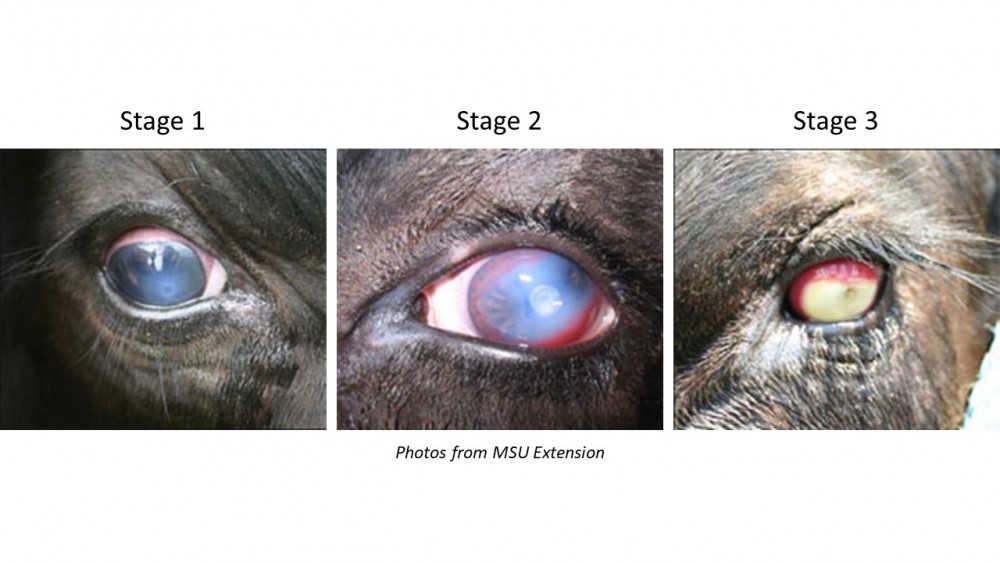
Summer is typically when producers see a spike in infections, since UV light and face flies are at their peak, irritating eyes and transmitting the bacteria from infected to non-infected individuals. Dust and tall grasses can also be eye irritants and are also part of the summer season.
Of these four irritants, the one that producers have the most control over is face flies. Controlling face flies is most important to limit the spread of the disease. This can be done through pesticide applications and/or an integrated pest management (IPM) program. Rotational grazing can be part of these such programs. Because these flies take 10-21 days to complete their lifecycle, if cattle are moved from pastures before the flies hatch, it can help limit the infestation. Additionally, if a farm has the flexibility in their breeding program, animals which show higher levels of parasite resistance can be selected for.
The best way to treat this disease is through prevention. Unfortunately, vaccines are not very effective if they are not targeted toward the specific strain of bacteria you have on your farm. If pinkeye still shows up in the herd after vaccinating and adopting management practices to limit face flies, using antibiotics is an effective way to treat affected individuals. Keep in mind that an outbreak is considered when 5% -10% of the animals are affected. Treating early will help limit potential production losses. Talk to your veterinarian about treatment options.
For more information on pinkeye management options, contact Livestock and Beginning Farm Specialist, Amy Barkley, at amb544@cornell.edu or (716) 640-0844.
The following articles have been referenced in this write-up, and may be helpful follow-up resources:
Pinkeye in Beef Cattle, Virginia Cooperative Extension
Pinkeye In Cattle, Michigan State University Part 1
Pinkeye In Cattle, Michigan State University Part 2
Pinkeye In Cattle, Michigan State University Part 3
The Easiest Way to Treat Pinkeye, On Pasture
Treatment of Pinkeye in Cattle, Virginia Tech Cooperative Extension
Upcoming Events
Crops, Cows & Critters - Southwest New York Dairy, Livestock & Field Crops Newsletter Sponsorship
December 19, 2025
Our two forms of publications feature research-based and timely information from our four specialists, listed to the right, along with local event notifications and Cornell University outreach. This information is provided to participants who range from dairy, livestock, and field crops producers to agricultural suppliers and consultants.
Weekly Email Update: Shared with 625+ households who have signed up with our program.
Monthly Paper Mailer: To reach our stakeholders and farmers who lack internet access, we send out a monthly mailer where your company's logo and contact information would be featured with a mailing list of 330+ households.
If you sponsor our weekly and monthly publications you reach approximately 955 households.
Visit our website to view our newsletters!
2025 Cornell Food Beverage & Animal Feed Manufacturer Survey
December 19, 2025
Industry and Educational Advocates for New York State's Food, Beverage, and Animal Feed Manufacturing industries:
As you know, NYS has a diverse food and beverage manufacturing industry, in both the types of industries that exist and the wide distribution of firms by scale. Many manufacturing firms have strong backward linkages to agricultural production sectors in the state that support both farm-level and downstream food industry firms and consumers. In collaboration with the New York State Department of Agriculture and Markets, a team from Cornell University's Charles H. Dyson School of Applied Economics and Management has recently rolled out the 2025 New York State Food, Beverage, and Animal Feed Manufacturer Survey. The industry will benefit from an updated assessment of the industry that informs private and public investments and opportunities to support firm growth and improved profitability.
Cornell Organic Field Crops & Dairy Conference
March 6, 2026
Waterloo, NY
Farmers, researchers, educators, and agricultural service providers from across the Northeast are invited to the 2026 Cornell Organic Field Crops & Dairy Conference, held Friday, March 6, 2026, from 8:00 a.m. to 4:30 p.m. at the Lux Hotel & Conference Center in Waterloo, N.Y.
Co-hosted by New York Soil Health and Cornell CALS, the annual conference brings together leaders in organic grain, dairy, and livestock systems to share practical tools, new research, and farmer-tested strategies to support resilient and profitable organic production.
Announcements
No announcements at this time.


